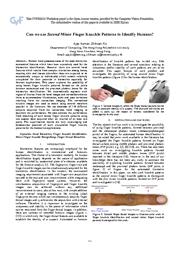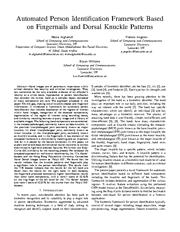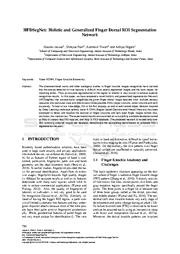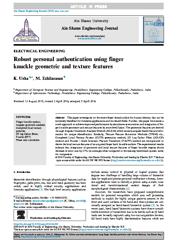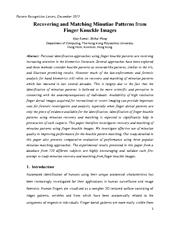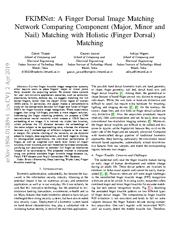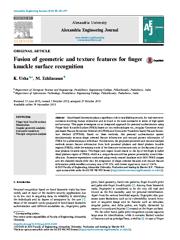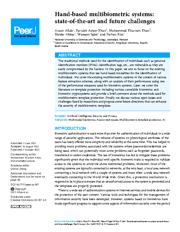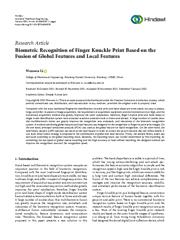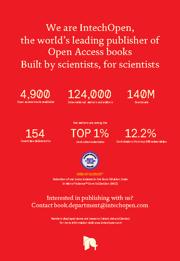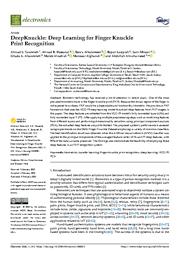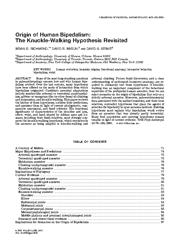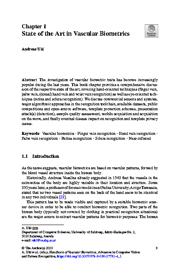A copy of this work was available on the public web and has been preserved in the Wayback Machine. The capture dates from 2017; you can also visit the original URL.
The file type is application/pdf.
Filters
Can We Use Second Minor Finger Knuckle Patterns to Identify Humans?
2014
2014 IEEE Conference on Computer Vision and Pattern Recognition Workshops
This paper explores the possibility of using lowest finger knuckle patterns formed on the joints between metacarpal and the proximal phalanx bones for the biometrics identification. ...
We also evaluate the performance from matching of such lowest finger knuckle patterns using two session data acquired after an interval of at least two years. ...
CONCLUSIONS AND FURTHER WORK This paper has investigated the possibility of using second minor finger knuckle image for the personal identification. ...
doi:10.1109/cvprw.2014.21
dblp:conf/cvpr/KumarX14
fatcat:wsetjznyxfckvi4n5il5ejridi
Automated Person Identification Framework Based on Fingernails and Dorsal Knuckle Patterns
2021
2021 IEEE Symposium Series on Computational Intelligence (SSCI)
We found that the results indicate that the knuckle patterns and fingernails play a significant role in the person identification. ...
joint, commonly known as minor knuckle; iv) the interphalangeal joint, commonly known as thumb's knuckle, and v) the fingernails. ...
Fig. 1 : 1 Fig. 1: The schematic diagram of the proposed framework for person identification based on f ingernails and dorsal knuckle patterns (PIFK) from the hand image.The proposed PIFK framework consists ...
doi:10.1109/ssci50451.2021.9659850
fatcat:sr4l523klrfibiq5nm7kklkzca
HFDSegNet: Holistic and Generalized Finger Dorsal ROI Segmentation Network
2019
Proceedings of the 8th International Conference on Pattern Recognition Applications and Methods
particular class and then extracts three possible ROIs (major knuckle, minor knuckle and nail) accurately. ...
In this paper, we have proposed a novel holistic and generalized segmentation Network (HFDSegNet) that automatically categorizes the given finger dorsal image obtained from multiple sensory resources into ...
In another hand dorsal study (Kumar, 2014) , importance of lower minor finger knuckles and palm dorsal region for personal authentication is discussed. ...
doi:10.5220/0007568307860793
dblp:conf/icpram/JaswalPTN19
fatcat:bfm6phezrngupezhrbk4fkh5xm
Robust personal authentication using finger knuckle geometric and texture features
2016
Ain Shams Engineering Journal
features of an acquired finger back knuckle surface. ...
This paper investigates on the entire finger dorsal surface for human identity that can be extremely beneficial for forensics applications and its related fields. ...
and wrinkles for identification, (ii) unlike fingerprint, the patterns of finger knuckle surface were present in the inner surface of the hand which is very difficult to be spoofed, (iii) unlike palm ...
doi:10.1016/j.asej.2016.04.006
fatcat:zpu2sq3rbzfijgpi5l4xwqvrky
Recovering and matching minutiae patterns from finger knuckle images
2015
Pattern Recognition Letters
Personal identification approaches using finger knuckle patterns are receiving increasing attention in the biometrics literature. ...
Identification of finger knuckle patterns using minutiae recovery and matching is expected to significantly help in prosecution of such suspects. ...
Finger dorsal images also illustrate minor knuckle patterns that can be employed [22] for personal identification and also used to improve the accuracy of performance that can be obtained from the simultaneously ...
doi:10.1016/j.patrec.2015.08.013
fatcat:f35b6npd7bd6jfrqpjxooajejy
FKIMNet: A Finger Dorsal Image Matching Network Comparing Component (Major, Minor and Nail) Matching with Holistic (Finger Dorsal) Matching
[article]
2019
arXiv
pre-print
To extend these systems for user non-intrusive application scenarios, such as consumer electronics, forensic, defence etc, we suggest matching the full dorsal fingers, rather than the major/ minor region ...
Current finger knuckle image recognition systems, often require users to place fingers' major or minor joints flatly towards the capturing sensor. ...
The lower minor knuckle and palm dorsal texture were fused using two separate data-sets and the results signified the potential of dorsal texture as a biometric identifier. ...
arXiv:1904.01289v1
fatcat:4hm7l3pebbgq5lb4m7to4uvp7i
Fusion of geometric and texture features for finger knuckle surface recognition
2016
Alexandria Engineering Journal
This paper investigates on an integrated approach for personal authentication using Finger Back Knuckle Surface (FBKS) based on two methodologies viz., Angular Geometric Analysis based Feature Extraction ...
Based on these methods, this personal authentication system simultaneously extracts shape oriented feature information and textural pattern information of FBKS for authenticating an individual. ...
[15] proposed a new personal authentication system using finger knuckle surface. ...
doi:10.1016/j.aej.2015.10.003
fatcat:yzy3sepndrf7riqb5k4t52ruq4
Hand-based multibiometric systems: state-of-the-art and future challenges
2021
PeerJ Computer Science
The traditional methods used for the identification of individuals such as personal identification numbers (PINs), identification tags, etc., are vulnerable as they are easily compromised by the hackers ...
In this paper, we aim to focus on the existing multibiometric systems that use hand based modalities for the identification of individuals. ...
Vein patterns are segmented into different sub-modalities amongst them most commonly used come from the palm (Zhou & Kumar, 2011) , palm dorsal (Joardar, Chatterjee & Rakshit, 2014), wrist (Pascual et ...
doi:10.7717/peerj-cs.707
pmid:34712793
pmcid:PMC8507475
fatcat:aejhjsxfbnhtzeiyggynamkbim
Biometric Recognition of Finger Knuckle Print Based on the Fusion of Global Features and Local Features
2022
Journal of Healthcare Engineering
Compared with the most traditional fingerprint identification, knuckle print and hand shape are more stable, not easy to abrase, forge, and pilfer; in aspect of image acquisition, the requirement of acquisition ...
equipment and environment are not high; and the noncontact acquisition method also greatly improves the users' satisfaction; therefore, finger knuckle print and hand shape of single-mode identification ...
Vidhyapriya has proposed a method for secure biometrics authentication using finger knuckle print (FKP). e texture patterns from finger knuckle are extracted using Gabor with exception-maximization (EM ...
doi:10.1155/2022/6041828
pmid:35035848
pmcid:PMC8759861
fatcat:lkhfg43olfejlfvrxjj3bu3a5u
Image Sharpness-Based System Design for Touchless Palmprint Recognition
[chapter]
2020
Biometric Systems [Working Title]
The experiment results are obtained using different algorithms on various touchless palmprint databases collected using different kinds of devices. They could be references for new system design. ...
Secondly, the relationship between the palm distance in the field of view (FOV) and image pixels per inch (PPI) is studied based on the imaging model. ...
Our palms are not pure planes, and many personal characteristics lie on the palm surface. From this view, 2D palmprint recognition has some inherent drawbacks. ...
doi:10.5772/intechopen.92828
fatcat:4kka47ggpnf4va6ckfjt6yrz3q
DeepKnuckle: Deep Learning for Finger Knuckle Print Recognition
2022
Electronics
One of the most prevalent biometric traits is the finger-knuckle print (FKP). Because the dorsal region of the finger is not exposed to surfaces, FKP would be a dependable and trustworthy biometric. ...
We provide an FKP framework that uses the VGG-19 deep learning model to extract deep features from FKP images in this paper. ...
The finger knuckle print is a global, one-of-a-kind, and persistent biometric pattern that is utilized for extremely exact personal identification. ...
doi:10.3390/electronics11040513
fatcat:oxt7sajqnveyvpklfhb5hn36x4
Origin of human bipedalism: The knuckle-walking hypothesis revisited
2001
American Journal of Physical Anthropology
Over the last century, many hypotheses have been offered on the mode of locomotion from which bipedalism originated. ...
Existing hypotheses must explain why bipedalism would evolve from an ancestor that was already partly terrestrial. ...
R, distal end of dorsal radius; S, scaphoid, dorsal margin; C, capitate, dorsal margin; P, pisiform. articular surfaces from a view perpendicular to the distal joint surface. ...
doi:10.1002/ajpa.10019.abs
pmid:11786992
fatcat:fqy766lxabdnbmqyxycfh2wmue
Origin of human bipedalism: The knuckle-walking hypothesis revisited
2001
American Journal of Physical Anthropology
Over the last century, many hypotheses have been offered on the mode of locomotion from which bipedalism originated. ...
Existing hypotheses must explain why bipedalism would evolve from an ancestor that was already partly terrestrial. ...
R, distal end of dorsal radius; S, scaphoid, dorsal margin; C, capitate, dorsal margin; P, pisiform. articular surfaces from a view perpendicular to the distal joint surface. ...
doi:10.1002/ajpa.10019
fatcat:hbklz7zj45hy7ojdxish3dkcha
11. The Simplified Sign System Lexicon
[chapter]
2020
Simplified Signs
A fingerprint is the oily impression of a fingertip on a surface. The patterns of each fingerprint are unique to an individual and may be used for identification purposes. ...
Unfortunately, signs that are highly transparent or translucent constitute only a minority of all the signs present in the sign languages used by Deaf persons. ...
Take chapters or whole books from our published list and make a special edition, a new anthology or an illuminating coursepack. ...
doi:10.11647/obp.0220.02
fatcat:5f75336euzebnnsgmn6bohzkjm
State of the Art in Vascular Biometrics
[chapter]
2019
Advances in Computer Vision and Pattern Recognition
This book chapter provides a comprehensive discussion of the respective state of the art, covering hand-oriented techniques (finger vein, palm vein, (dorsal) hand vein and wrist vein recognition) as well ...
[86] use dorsal hand veins as well as palm veins while [28] fuse palmprint, palm-phalanges print and dorsal hand vein recognition. ...
Binary finger vein patterns generated using these techniques have been extracted from both the dorsal and palmar finger sides in a comparison [112] . ...
doi:10.1007/978-3-030-27731-4_1
fatcat:e3kxblj74verhaouxrjmnt6axe
« Previous
Showing results 1 — 15 out of 88 results

